To optimize your holiday sales, it’s a good idea to look at forecasts, trends, and relevant stats about customers’ shopping habits and preferences.
I’ve written this type of post in the past. And I think the information is useful. So I wanted to create a similar post this year, especially since the world has turned topsy-turvey on account of the pandemic and shopping habits have changed.
In the 2020 edition, I look at 10 important facts and insights about this year’s holiday season as they pertain to the Low Hanging System. Plus, I let you know this year’s must-know shipping deadlines so you can prepare.
There’s a lot of information to cover. So without further adieu, here’s what you need to know to make 2020 your best holiday season yet…
#1. People are expected to spend less this holiday season overall, but that doesn’t necessarily apply to gifts.
According to the 2020 Deloitte Holiday Retail Survey, “Shoppers expect to spend an average of $1,387 per household during the holiday season, down 7% YoY.” And of that $1,387, $487 is expected to be spent on gifts and gift cards.
NOTE: This stat factors in ALL holiday spending, including travel expenses, entertaining, and non-gift purchases. See the image below.
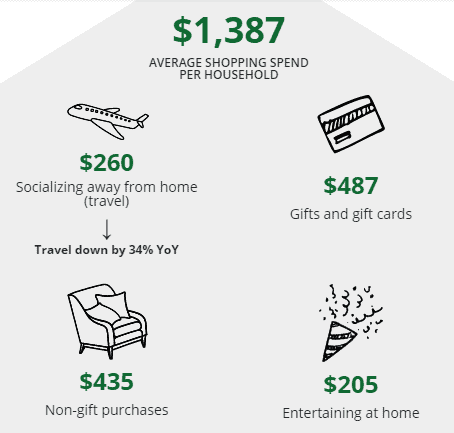
So this doesn’t necessarily mean you won’t earn as many sales this holiday season. Since people will be spending less money on travel, dining out, and entertaining, that leaves more money in their pockets for gifts.
The Tinuiti 2020 Holiday Shopping Trends Report says, “More than 8 in 10 consumers (81.3%) said they plan to spend about the same or more on holiday gifts—the highest level in the past three years.”
This means that less than 19% of people plan on spending less on gifts this year. The people who say they plan on spending less tend to be older (aged 55+). While the people who plan on spending more tend to be male and younger than 40.
#2. The average shopping window is significantly shorter this year.
Deloitte says, “Consumers plan to start shopping the same time that they did last year, but the average shopping window has significantly shortened to 5.9 weeks, compared to last year’s 7.4 weeks.”
Also, 60% of customers say they prefer shopping online as opposed to going to a brick-and-mortar store during the holidays. And almost half (47%) of customers say they won’t be shopping on major retail holidays, including Black Friday and Cyber Monday. This is, in part, to avoid large crowds.

And while the average shopper plans to start shopping at the same time this year, “super spenders” (people whose holiday budgets exceed $500), especially women, plan on shopping earlier. So you want to get your business “holiday ready” asap.
A great way to attract shoppers, in general, is to run a holiday sale. But if you run your sale over the next few weeks, before Black Friday and Cyber Monday, you can appeal to some of these super spenders. This is also a good idea because a lot of people don’t plan on shopping over the retail holidays.
#3. Covid-19 will affect holiday shopping in several ways.
Most notably, more people (45.3%) plan on doing more online shopping (more details on this in #4). Additionally, 34.8% of people say they plan on attending fewer family gatherings. And 26.2% say they will travel less by air over the holidays.
Check out the chart below:
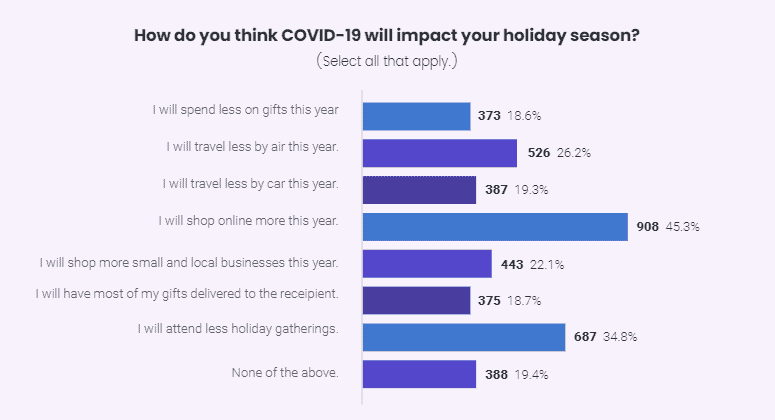
How people feel about COVID-19 and their holiday plans also varies by region. For example, people in the Northeast are most likely to care about shopping locally and supporting small businesses. And people in the South care the most about having their gifts delivered and shopping online.
Take a look at the chart below:
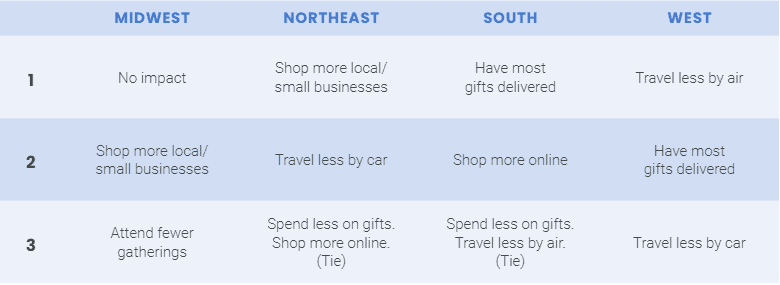
#4. Customers are shopping considerably more online.
As mentioned above, almost half (48.5%) of people in the Tinuiti report say they plan to “exclusively or predominantly” shop for the majority of their gifts online.

Millennials (people age 24-39) are especially likely to shop online this year, as are super spenders.
According to Deloitte, these are the top 5 reasons people prefer shopping online over brick-and-mortar stores this holiday season:
- Avoid crowds (65%)
- Comfort of shopping from home (64%)
- Free delivery/shipping options (60%)
- 24-hour availability (58%)
- Easy to compare prices (53%)
Safety concerns are also causing customers to avoid “browsing format” shops, like department stores, which is great for ecommerce sellers. One upside of all the craziness in the world has been that ecommerce has been booming. And the trend seems likely to continue throughout the holiday season.
#5. Customers want good deals on the items they want most.
Price is important to customers. According to Tinuiti, regardless of a customer’s age, spending level, or preferred shopping channel, they care a lot about pricing. Customers also value sales or discounts and free shipping. They don’t care as much about the ease of returns.
Check out the chart below:
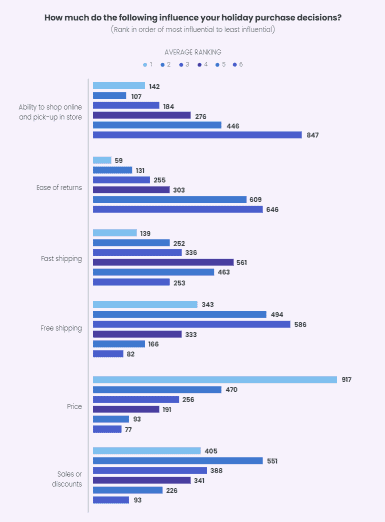
It’s a little bit hard to see, but a strong majority of people (917) ranked price as the number one influence on their holiday purchasing decisions followed by sales or discounts, free shipping, the ability to shop online and pickup in-store, fast shipping, and ease of returns.
Now, for LHS purposes, I’ve said that pricing isn’t always a big deal. But given what the Tinuiti report indicates, here’s what you can do…
In the description of your top-performing products (don’t do this for everything you sell), you can compare your products to other more expensive items to establish an anchor.
For example, you might say, “Other gifts go for $50 or $100+. But this mug costs less than $20. Plus, it has a super meaningful message that’s sure to tug on some heartstrings.”
It’s interesting to note that free shipping trumps fast shipping. So if you’re able to offer free shipping, it seems worth it to do so. You can pad your product’s base cost by a few dollars to recoup some of the shipping expenses if you wanted.
In addition to seeking good deals on items they buy as gifts, customers also plan on treating themselves this year with the following types of items:
- Food (33%)
- Beverages (30%)
- Clothes (30%)
Plus, 50% of the Deloitte survey respondents say they intend to purchase pet items over the holidays.
This knowledge can help inform the types of designs you create, the products you sell, and the way you market your products.
No food or drinks are sold with the Low Hanging System. But items like coffee mugs, shot glasses, and tumblers are. And in their descriptions, you can say things like…
“This coffee mug makes a great gift, especially when paired with a gourmet bag of coffee or hot chocolate. It’s the perfect way to treat either yourself or someone special this holiday season.”
This helps link what Deloitte says customers are looking for this year to your products even though you don’t specifically sell any food or beverage items.
Also, since Deloitte says clothing is going to be big, you can add more t-shirts and tank tops to your inventory. And since customers are going to look for pet items, you can add more pet-related designs to your products.
#6. You can expect to see 4 main types of shoppers this holiday season.
According to Deloitte, the 4 types are…
1. Festive shopper – This type of shopper tends to spend the most. Festive shoppers are very into buying gifts for people. They are typically over the age of 55.
2. Conscious shopper – Conscious shoppers care about being socially responsible. And they are willing to pay a little more for products that meet this standard. They are mostly people age 44 or younger.
3. Deal-seeker – Deal-seekers take their time shopping. They want to find the perfect gift at an affordable price. This type of shopper searches digital platforms and social media for good deals. They typically come from middle-income households.
4. Efficient shopper – This type of shopper is very time-conscious. Efficient shoppers don’t want to do a lot of browsing. They want to get in, get what they need, and get out. The majority of efficient shoppers are men.
Depending on who your shop’s target audience is, you can tailor your products’ descriptions to better appeal to their target holiday shopper.
For example, if your target shopper is a…
Festive shopper – You might ham up what great gifts your items make. Or you might pitch the idea of buying items in sets. So instead of buying just one coffee mug, why not buy 6 as part of a dining set for the whole family?
Conscious shopper – You could highlight how your items are shipped in recyclable foam mailers that have a .07% break rate.
Deal-seeker – You might mention how other gift ideas cost more, but your products are both meaningful and budget-friendly.
Efficient shopper – You could talk about how your store is a one-stop-shop for everyone’s gift-buying needs. You might also offer bundle deals, making it even easier for efficient shoppers to find everything they’re looking for all at once.
#7. Customers love Amazon but they also want to support small and local businesses.
The majority of holiday shopping will occur via mass merchants and Amazon, according to Tinuiti.
Check out the chart below:
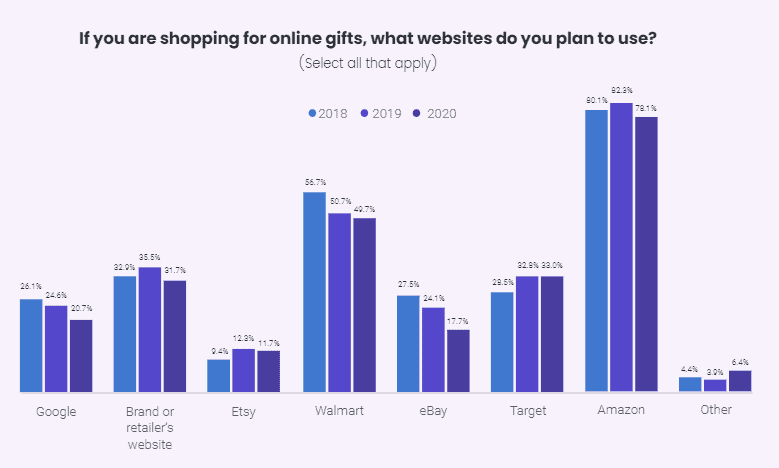
But around 25% of customers say they also want to support small and local businesses (more so than department stores and member warehouses, like Costco).
#8. Customers want a personalized shopping experience and dedicated support.
Customers want to feel understood. They want to feel cared about. A personalized shopping experience matters to them.
And the best way that you can convey these things is through your customer support. “Even when something goes wrong, a positive customer support experience can lead to a loyal
customer,” says Big Commerce.
Here are a few tips for improving your holiday customer service:
- Address customers by name whenever possible.
- Respond to all inquiries within 24 hours.
- Follow up with customers by asking how their experience was with your business.
- Create customer service scripts to help you save time (you can learn more about that here).
#9. Customers want to support businesses that support racial equality.
This year, protests for racial equality have been occurring all over the country. And one of the ways that activists have called for people to support the Black Lives Matter movement is by frequenting Black-owned businesses.
(A while back, I wrote a blog post about this, which you can check out here. The post shares a list of business resources from Black entrepreneurs and ecommerce experts.)
A growing number of customers have been heeding this call to action. According to the Tinuiti report…
“More than 1 in 5 shoppers (21%) will patronize Black-owned businesses or brands that have expressed support for the Black Lives Matter movement. Younger shoppers are more likely to take up this cause, with nearly 4 in 10 (39.6%) of Gen Z shoppers saying their holiday spending would be impacted; specifically, 27.9% will shop with more or only Black-owned businesses.”
If you’re going to say you support #BLM, you have to be genuine, though. You can’t just say you support the movement without taking concrete action. If you’re going to participate in “cause marketing,” you have to mean it. And you should. This is an incredibly worthwhile cause.
One way you can show that you’re sincere and not just blowing smoke is to form charitable partnerships and make donations to relevant organizations, especially those that support your local community.
Here’s a list of good organizations to support:
- ACLU
- Grassroots Law Project
- The Antiracist Research & Policy Center
- Showing Up For Racial Justice
- Black Lives Matter
- RAICES
- Equal Justice Initiative
- The Great Unlearn
- NAACP
- Check Your Privilege
- No White Saviors
#10. The 2020 Holiday shipping deadlines within the US start on December 9th.
Learn when the rest of the 2020 holiday shipping deadlines are below:
USPS
Retail Ground – December 15
First Class Mail – December 18
Priority Mail – December 19
Priority Mail Express – December 23
FedEx
SmartPost – December 9 (with exceptions)
Ground – December 15
Home Delivery – December 15
Express Saver – December 21
2Day Services – December 22
Overnight Services – December 23
UPS
Ground – December 15
3 Day Select – December 21
2nd Day Air Services – December 22
Next Day Air Services – December 23
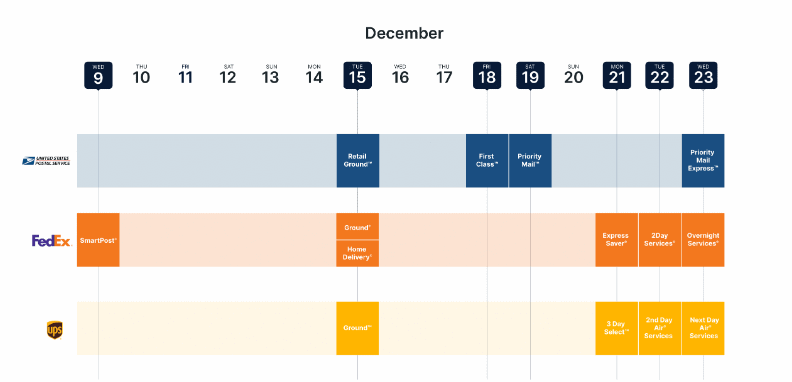
I hope you find these holiday shopping insights to be useful and interesting! Leave a comment below and let me know what you think. And if you enjoyed this post, please consider sharing it!






1 thought on “Top holiday insights – A compilation of fascinating facts about holiday shoppers (updated)”
Very good read. I know shipping times will be a bit different here in Canada. I should be able to check with our post office on delivery times,, then add another day or two.